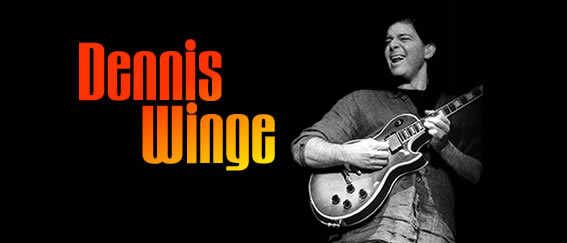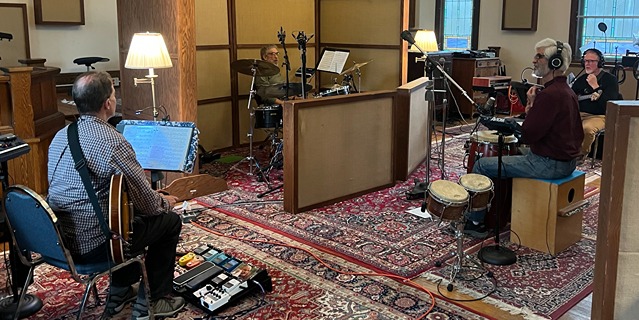One Year, One Album: The Journey to Sunset Salsa’s Debut Recording
In March 2025, my band Sunset Salsa recorded our debut album—a milestone that was over a year in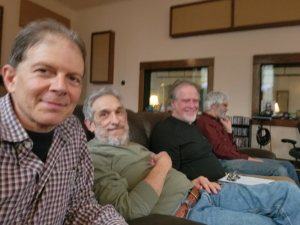 the making. What started as a setlist for a local gig turned into a deep dive into salsa, merengue, bachata, and Latin jazz. This post is a behind-the-scenes look at everything that led up to that weekend in the studio: the arranging, the rehearsing, the experiments, the setbacks, and the breakthroughs. If you’ve ever wondered what it really takes to make an album, here’s the story.
the making. What started as a setlist for a local gig turned into a deep dive into salsa, merengue, bachata, and Latin jazz. This post is a behind-the-scenes look at everything that led up to that weekend in the studio: the arranging, the rehearsing, the experiments, the setbacks, and the breakthroughs. If you’ve ever wondered what it really takes to make an album, here’s the story.
Seeds of the Idea
Almost a year ago, the first seeds of this album were planted—not in a studio, but at a gig at a local brewery. We were playing on Cinco De Mayo, and I had to learn a whole bunch of tunes for that show: a mix of Latin jazz standards and Santana classics like “Europa” and “Black Magic Woman.” I was deep in learning mode—listening, transcribing, writing out charts, and rehearsing them with the bassist for months. Looking back, that was the first step on what turned into a yearlong journey.
That show was probably in the winter of 2024, and now here we are in the winter of 2025, and I’m still learning—still discovering more about salsa, merengue, and bachata. But it all began with that early spark: the challenge of arranging Latin repertoire for a smaller group, making it groove, and keeping the essence of the original while still making it my own.
From Tunes to Arrangements
Once I had a few tunes under my fingers, the real work began. It’s one thing to learn a song, but it’s 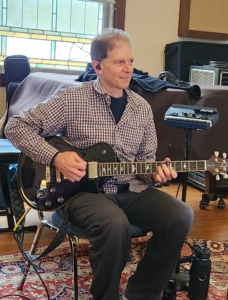 another to make it playable, performable, and personal—especially as a guitarist in a Latin band setting where there’s often no piano or horns to fill in the gaps.
another to make it playable, performable, and personal—especially as a guitarist in a Latin band setting where there’s often no piano or horns to fill in the gaps.
Every song required a process: first, I’d listen to several recordings to internalize the vibe. Then I had to decide on a key that worked well for guitar—some of these originals are in awkward keys, and I needed to strike a balance between playability and authenticity. After that came the challenge of figuring out how to play both the melody and the chords at the same time, which often required arranging things note by note.
Once I had something that worked, I’d write out the charts for the bassist. That alone could take days. And some arrangements took weeks to really lock in. The songs had to feel natural, danceable, and still have enough harmonic interest to keep it musically satisfying. It was a slow grind, but one I’ve come to enjoy. There’s a weird satisfaction that comes from carving out your own version of a classic and making it work for the players you’ve got.
Finding the Groove with Classic Salsa Tunes
Not long after those early gigs, I had the opportunity to play with another local salsa band. That experience was a turning point. Playing with them gave me a taste of what more “authentic” salsa feels like in a live setting—not just the notes, but the energy, the drive, the deep groove that makes people want to dance.
It lit a fire under me. I started transcribing tunes that stood out—songs like Pa’lla Voy by Marc Anthony and Idilio by Willie Colón. Both of those ended up making it onto the album. They weren’t just fun to play—they had soul and swagger, and I loved the way the crowd responded to them.
I also discovered just how much fun it is to play merengue. At that time, I only knew one merengue tune—Compadre Pedro Juan, which happens to be the only merengue song in the Latin Real Book. But Salsa Libre introduced me to another favorite: Pégame Tu Vicio. I was instantly drawn to its energy, and eventually, I figured out how to stitch the two songs together into a medley that’s now on the album.
That’s kind of how this whole project started to shape itself. One gig would lead to a tune, which would lead to an arrangement, which would lead to a new idea. Slowly but surely, a full album concept began to emerge. Read more about my journey with Salsa Libre here.
Why No Piano or Horns?
A lot of people ask, “Where’s the piano? Where’s the horn section?” And believe me—I thought about it. I even considered bringing in a pianist or saxophonist at one point. But in the end, I decided to keep the core band small: guitar, bass, and percussion.
It’s not easy to make salsa work with that instrumentation. As the guitarist, I have to handle the melody, the harmony, the montunos, and all the solos. It’s a lot of responsibility—but it also forces me to play with intention. And in the long run, I think it made me a better musician.
There were practical reasons too. Fewer people means fewer schedules to juggle, fewer charts to write and transpose, and fewer moving parts. But it was also an artistic choice. I reminded myself: if players like Luis Salinas and Marc Ribot can do it, I can too.
I worked harder on these arrangements than I’ve ever worked in my life. But the payoff is freedom. We can still bring in horns or keys when we want to—but we don’t need to. In fact, we’ve already done trio gigs that held their own, and that’s a great feeling. I also worked on my time-feel a lot. A year ago I played some unaccompanied Latin Jazz tunes at an open mic and felt beat up afterwards. Fast forward about 6 months and I did the same thing again at a different venue and it came out nice.
Creative Experimentation: Medleys & Mashups
As I kept building the repertoire, I found myself wanting to push the boundaries of what a Latin set could be. Not just traditional covers, but creative reimaginings—something uniquely us. That’s when the medleys started happening.
One of the earliest ideas was combining La Bamba with the jazz standard Secret Love. On paper, they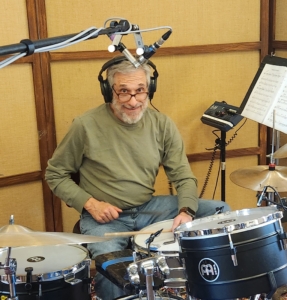 don’t seem like they belong together—but in practice, it worked surprisingly well. The rhythmic shift gave Secret Love a whole new flavor, and La Bamba grounded it in something instantly familiar.
don’t seem like they belong together—but in practice, it worked surprisingly well. The rhythmic shift gave Secret Love a whole new flavor, and La Bamba grounded it in something instantly familiar.
Then came the medley I call I Like It Smooth Mucho. It’s a mashup of Smooth Operator (yes, the Sade tune), Bésame Mucho, and I Like It Like That. Three totally different songs, but somehow they flowed into each other with ease. I played around with keys, grooves, and transitions until the whole thing felt seamless. It became one of our most crowd-pleasing arrangements, and I knew it had to be on the album.
I love this kind of creative work—taking songs that don’t usually sit next to each other and making them dance together. It’s like musical collage-making, but with real emotional and rhythmic glue holding it all in place.
Adding Bachata
The idea to include bachata on the album came from Jorge Cuevas, our percussionist and my right-hand man throughout this whole project. We were talking about the vision for the album—who it was for, where it might be played—and I told him I wanted it to appeal to both listeners and dancers. That’s when he said, “You might want to add some bachata. It’s really in demand right now.”
I’ll admit, at first I wasn’t sold. I spent several days listening to bachata playlists and, honestly, a lot of it sounded kind of bland to me. Not bad, just… forgettable. I had trouble finding something that felt musically rich enough to inspire an arrangement.
But then I stumbled on Bachata en Fukuoka by Juan Luis Guerra. Right away, I was hooked. The harmony was interesting, the melody was lyrical—it stood out from the crowd. I knew I wanted to learn it, and when I sent it to Jorge, he lit up. Turned out it was one of his all-time favorite bachata tracks. That sealed the deal.
Still, I needed one more bachata to round things out. I tried putting Alone Together to a bachata groove—made a YouTube video of it even—but it didn’t quite have the flair I was looking for. Eventually, I took a left turn and started digging through my jazz repertoire. That’s when Nostalgia in Times Square by Charles Mingus jumped out at me. A weird choice? Maybe. But the melody had bite, and I thought it could work.
Recording that one in the studio was tricky—it didn’t come out sounding perfectly bachata right away—but I think we captured something special with it. It’s got character. And sometimes, character is more important than genre purity.
Tempo Truths
One of the best things I did in the lead-up to recording was go on the Salsa Cruise, organized by Salsa Ithaca. It was a night of dancing out on the water with great people and great music—and it turned into an unexpected research opportunity.
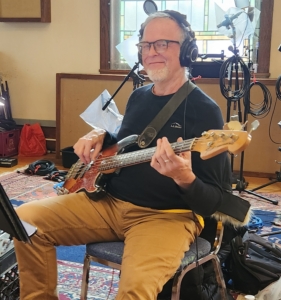 While everyone else was hitting the dance floor, I pulled out the metronome app on my phone and started clocking tempos. I wanted to know: what’s the real-world dance tempo for these styles? Turns out, it was incredibly useful. I found that the average salsa tempo was around 95 for the half note, bachata averaged about 67, and merengue hit around 139. That information stuck with me.
While everyone else was hitting the dance floor, I pulled out the metronome app on my phone and started clocking tempos. I wanted to know: what’s the real-world dance tempo for these styles? Turns out, it was incredibly useful. I found that the average salsa tempo was around 95 for the half note, bachata averaged about 67, and merengue hit around 139. That information stuck with me.
Why did it matter? Because I’d also been checking out Latin jazz recordings and play-alongs, like the Salsa/Latin Jazz volume from the Jamey Aebersold series. A lot of those tracks are way too fast—half note = 100 and up. Great for practicing soloing, maybe, but not ideal for dancers. And this album wasn’t just a jazz record—it had to move bodies.
So when it came time to arrange and record, I made a deliberate choice to keep our tempos dancer-friendly. With the exception of Nardis—which we turned into a fiery Mozambique groove—we kept everything at or below that half note = 100 threshold. That little decision made a big difference. The music still feels alive and exciting, but it’s also grounded in real danceability.
Rehearsals and Rituals
One of the smartest moves I made was choosing when to record. I planned the sessions for early March, which is usually a quiet time for musicians in the Finger Lakes. Trying to organize something this big in the middle of summer gig season would’ve been a logistical nightmare. But in March? Everyone had time—and more importantly, mental space.
Back in October, I took Jorge out for lunch and told him what I was planning. From then on, I started building the rehearsal schedule, slowly but steadily. Over the next few months, we rehearsed consistently—me with the full band, and also just with the bassist when needed. I even uploaded rehearsal audio for everyone to practice with between sessions. I wanted everyone to feel totally locked in before we hit the studio.
Meanwhile, I was practicing like never before. For five or six months, these songs were part of my daily routine. Not just brushing them up here and there—I mean deep, focused practice. Playing them over and over until they lived in my fingers. I don’t think I’ve ever prepared this thoroughly for a recording in my life. We also played a few gigs together such as our “Joy of Latin Jazz: Interactive Concert.”
And it paid off. When I finally walked the studio for day one of tracking, I was relaxed. I smiled. I wasn’t worried—I was ready. In fact, I even led a little chanting ritual with the band both mornings before we started recording. Nothing fancy, just a moment of focus and intention. But it mattered. That combo of deep preparation and a positive mindset set the tone for the whole weekend.
The Recording Sessions
We recorded the album at my go-to studio. The room sounds amazing, the gear is top-notch, and the atmosphere is relaxed but focused. It’s the kind of place where you can get serious work done without feeling like you’re under a microscope. Perfect for what we were about to take on. I described the experience in even more detail here.
Day One was a marathon. We tracked nine songs that day. No easing in—just straight to work. I was calling takes, managing the pace, and doing my best to keep everyone energized. The band absolutely delivered, but I’ll be honest: I didn’t realize how hard I was pushing us until I woke up the next morning feeling like I’d been hit by a truck. No alcohol involved—just pure musical exhaustion.
I joked with the guys that I’d turned into a bit of a taskmaster. They laughed, but I could tell they felt it too. Still, they hung in. The vibe was supportive and locked in.
Day Two, we tracked the final three songs and redid one from the previous day. By around 1 p.m., we were done with recording. But the day wasn’t over—we spent the rest of it listening back to every take, picking the best ones for each tune. That kind of focused listening takes a different kind of energy. It’s mental. It’s draining. You’re not just listening for mistakes—you’re listening for magic. For feel. For vibe. And making those decisions takes everything out of you.
Day Three, I came in solo to do a few guitar fixes. Just a few things that needed tightening up across the 12 tracks. I was in and out in about three hours, which is fast for that many songs. But even after just three hours of work, I was completely wiped. My brain was oatmeal. My fingers were toast. Still, I left the studio feeling good—like we’d really captured something worth preserving.
Reflections and the Bigger Picture
Now that the tracking is behind us, I’ve had some time to reflect—not just on the sessions, but on everything that led up to them. This album didn’t happen over a weekend. It was a year in the making. A year of studying, arranging, rehearsing, experimenting, and obsessing over the tiniest musical details. And while I’m still recovering (seriously—I was going to bed at 7:30 p.m. for a few days after the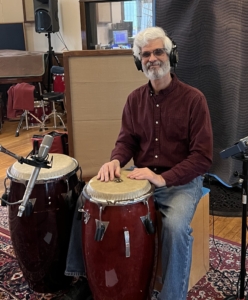 sessions), I’m also incredibly proud.
sessions), I’m also incredibly proud.
This project has reminded me how much work goes into making a record. People outside the music world sometimes think it’s just: write a few songs, show up, hit record. But it’s so much more. It’s pressure, it’s endurance, it’s decision after decision after decision. But it’s also deeply rewarding. It sharpens your musicianship in ways that nothing else does.
That’s why I encourage my students to record albums—whether it’s an EP, a full-length, or even just a single. The process forces you to level up. You hear yourself in a whole new light. You start thinking like an arranger, a producer, a performer, and a listener, all at once. It’s humbling—and empowering.
As for me, this is my 12th album… unless you count the chanting records I made under the name Damodar Das, in which case we’re probably closer to 25. And honestly, I don’t plan to stop until I’m physically unable to keep going. Making albums is part of who I am. It’s how I process my musical journey—and share it.
This album, in particular, feels like a turning point. It marks the beginning of Sunset Salsa, not just as a gigging band, but as a creative force. The songs are vibrant, the grooves are tight, and the energy is real. Whether you’re listening with headphones or hitting the dance floor, I think you’ll feel it. It’s a “perfect blend of music and atmosphere.”
I can’t wait for you to hear it. [EDIT: hear it here.
—
If you are planning a wedding, private party, or corporate event and you want to explore your options for musicians to provide live music, book a free music consultation with me or simply write to me on the contact page.
